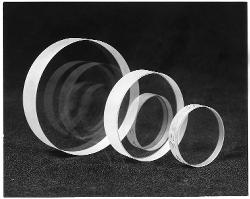
Optical contacting is a process by which two surfaces are adhered together through molecular attraction without the use of an adhesive. It is a technique which is used in the precision optical shop when it is necessary to eliminate the dimensional uncertainty of wax or adhesive. For example, because optical parts are held down on the holding plate (block) usually by wax, it can be seen that the finite thickness of the wax not only can vary from piece to piece, but can also be wedged. When the specification calls for tight parallelism or angle tolerance, usually below one minute, the optician will employ optical contacting. Another instance when optical contacting is utilized is when the specification requires a very tight tolerance on thickness, usually better than 0.02 mm. In the above examples, the optician will use the "contact plate" which is usually of fused silica or other transparent, low expansion material, and whose thickness is known to a precision of better than 0.001 mm. The surfaces of this plate are extremely parallel, 1/2 arc-second or better, with both sides very flat, at least 1/20-wave. The contacting process involves a technique
of cleaning the contacting surface of this plate to an exceptionally
high degree. The parts being manufactured have already been polished
extremely flat on one side. This side is likewise cleaned. The optician
then brings the two surfaces together, and this is where the optician's
skill comes into action, and the two surfaces literally adhere.
The parts are then "sealed" around the edges with shellac
or lacquer to prevent the polishing water from breaking the contact.
The optician then grinds and polishes the parts to specification,
knowing that there is zero dimension between the parts and the contact
plate. Certain finished products are contacted. These will usually
be used in high-power laser applications in which optical cement
could be damaged, or at wavelengths where optical cement will not
transmit, such as in the ultraviolet. Most optical cements are opaque
below 325 nm, although one brand transmits to 250 nm. Optical contacting
is a skill, and as in any art, one becomes proficient only with
practice. |
||||||||||||||||||||||||||||||||||||||||||||||||||||||||||||||
Optics
for Research ·
Ph 973-228-4480 · Fax 973-228-0915 · Email: info@ofr.com
![]()

